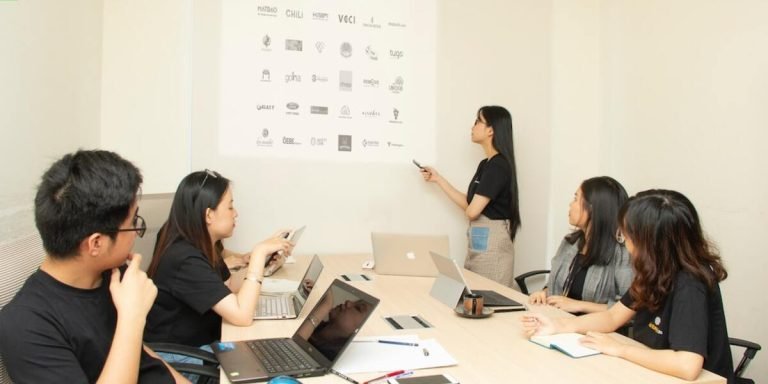What is Learning Content Management System: A Simplified Guide for Parents and Educators
Understanding “what is a Learning Content Management System (LCMS)” can be challenging, especially for parents and educators who are new to the digital aspect of learning. However, it’s an indispensable tool in present times that revolutionizes education by adding technology into the mix.
This article aims at simplifying LCMS and making this complex term comprehensible. It explores how this system works as part of Technology Integration in Education delivering quality content while enhancing learner experience – all done seamlessly within one platform.
Did you know?
Did you know that the Learning Content Management System (LCMS) market is predicted to grow 21% by 2028? This rapid increase shows how integral these systems are becoming in modern education.
Exploring Learning Content Management Systems: Defining the Basics
Learning Content Management Systems (LCMS) are becoming a cornerstone of modern education, fundamentally reshaping the way educators deliver learning materials to students. In its simplest form, an LCMS is a digital platform that allows educational material to be created, managed and delivered online. It’s much more than just digitizing textbooks; it optimizes content for individualized learning paths while also providing data analytics for monitoring student performance in real-time.
In today’s technology-driven world, integrating these systems into the curriculum becomes an increasingly necessary evolution in education sector. The growth of remote and blended learning models brought about by circumstances such as global pandemic events underscores this point vividly. Consequently, there has never been a greater need or opportunity to harness these platforms’ power to enhance both teaching efficiency and student engagement levels.
With user-friendly interfaces designed specifically with teachers and learners in mind combined with rich multimedia feature sets – interactive quizzes, videos on demand etc., LCMS can transform typical classroom scenarios into highly stimulating environments where knowledge processing extends beyond pen-and-paper methods thereby increasing overall comprehension rates among children.
Exploring Learning Content Management Systems further leads us down intriguing avenues of discovery: customized lesson planning features enable educators create unique experiences aligned not only towards course objectives but tailored according individual learner strengths & weaknesses identified through system generated insights too!
Understanding the Role of LCMS in Education Technology
A Learning Content Management System (LCMS) is a software application or platform that provides the necessary tools for creating, managing, and delivering educational content. When we ask “what is learning content management system”, we’re referring to this technology integration in education.
In simple terms, an LCMS combines two essential aspects that significantly impact 21st-century teaching: engaging digital content creation and efficient administration of these materials. This dual functionality serves as its primary distinction from traditional learning systems such as LMS (Learning Management Systems).
With rapidly evolving information technologies today, having access to accurate knowledge at one’s fingertips has never been more critical. And this holds true even within the realm of childhood education where our young learners are increasingly exposed to digitally-assisted study modes.
The role of LCMS comes into play here by enhancing teachers’ effectiveness through streamlining their process – from lesson planning right up until assessment report generation. It also enriches students’ academic journey with personalized course modules tailored according to individual preferences and capabilities; all while ensuring a secure virtual environment conducive for intellectual growth.
1. On-Demand Access: An LCMS enables seamless extraction and immediate distribution of specific learning units across multiple platforms catering different user groups- from formal classroom settings down to casual mobile app users.
2.The Flexibility Advantage: The ability it offers educators in customizing curriculum presentations aligning perfectly with diverse student needs sets apart LCMS within edTech advancements.
Key Features and Benefits of Implementing an LCMS
The integration of technology in education has become an essential part of the modern learning landscape. One such cornerstone is a Learning Content Management System (LCMS). Essentially, when we explore ‘what is Learning Content Management System?’, it’s fair to say that LCMS serves as the nerve center for content management and delivery in educational settings.
An LCMS incorporates key features specifically designed to augment teaching efficiency and supplement student learning experiences. The objective is not just to create effective lessons but also to manage them with unerring precision. Notable benefits of implementing an LCMS include:
1) **Efficient Content Delivery**: An integral aspect of any good LCMS involves streamlining content delivery across multiple channels seamlessly. This guarantees students receive lessons efficiently irrespective of geographical barriers or device types.
2) **Customization Options**: Enabling educators’ ability to personalize lesson plans according to individual student needs helps drive meaningful engagement – a boon made convenient by using an LCMS platform.
3) **Collaborative Tools**: The inclusion of social collaborative tools encourages interactions between peers, fostering innovation while cultivating critical thinking skills among learners simultaneously.
The Impact of LCMS on Teaching Methodologies and Student Engagement
In the evolving digital landscape of 2023, Learning Content Management Systems (LCMS) are leaving an indelible mark on teaching methodologies and student engagement. With its ability to centralize knowledge repositories and streamline content delivery across various platforms, LCMS is revolutionizing how educational material is created, managed, updated and accessed.
Being at the nexus of technology integration in education has allowed LCMS to transform traditional approaches into dynamic interactive learning experiences. Teachers now have access to a rich array of resources that can be tailored precisely according to students’ unique learning needs which keeps pedagogical processes adaptive rather than static. This flexibility translates directly into more personalized instruction that fosters deeper understanding thereby driving improved academic outcomes.
Furthermore, by democratizing content accessibility through mobile readiness and remote availability capabilities -woes associated with geographical constraints or time limitations become things of past for learners as well as educators alike! The advanced tracking features not only keep them motivated but also help in predicting areas needing attention thus leading towards proactive intervention strategies – resulting in sustained student engagement within conducive learning environments.
Revolutionizing Classroom Dynamics with Adaptive Learning Technologies
Understanding the advent of technology integration in education requires us to decipher what a learning content management system (LCMS) is. Simplified, an LCMS deals with digital educational resources by creating, managing, and delivering them efficiently.
Today’s advanced technology has manifested itself into adaptive learning technologies – intelligent tools that embrace student-centric approaches for enhancing their engagement levels. Leveraging these technologies revamps classroom dynamics substantially and provides multidimensional benefits.
Notably, the impact on teaching methodologies can’t be understated. Traditional lecture-based methods are evolving into interactive sessions fuelled with gamification elements enabled by integrations like virtual reality or augmented reality tools. Teachers report increased opportunities for personalized instruction as these systems process individual students’ data effectively to generate tailor-made lessons accommodating diverse learner styles.
The dynamism doesn’t end there though! Usage analytics derived from such systems empower teachers to tune their strategies based on real-time feedback about each child’s progress. Utilizing this information helps identify strengths and areas needing attention while also predicting potential roadblocks in advance – now isn’t that simply phenomenal?
Next up? Student Engagement; not just any level of engagement but a heightened one at that! Picture this: children being offered visually rich environments stimulating curiosity alongside well-structured multimedia content breaking down complex concepts easily further ignite intrinsic motivation among learners – everyone surely loves a captivating story!
But wait…it gets even better! The competitive yet healthy spirit fostered through leaderboards boosts determination levels encouraging continuous improvement fostering responsible behavior beneficial for holistic development beyond academics too).
Enhancing Collaborative Learning Through Integrated Digital Platforms
In essence, an LCMS equips teachers with effective tools for curating educational materials while also providing means for learners to actively participate during lessons.
Original content as is.
Firstly, these systems offer interactivity which helps keeping pupils’ attention focused on tasks at hand – a crucial element considering today’s children are growing up amid distractions galore due to smartphones and social media.
Secondly, using such software encourages group activities as everyone can share resources and ideas within one platform. This promotes teamwork among kids from early stages of education – a necessary skill in this interconnected world we live in.
Thirdly, when educators utilize modern technology integration methods into their classrooms using an LCMS or other similar technologies , they not only engage students dynamically but also foster critical thinking skills since assignment completion requires research capabilities along with creativity.
Lastly,Learning Content Management System enables quick feedback mechanisms so errors can be corrected promptly saving time for both teacher & pupil. This real-time assessment fosters better understanding by addressing misconceptions before they turn ingrained thus innovatively transforming conventional modes of pedagogy .
Strategies for Successful Integration of LCMS in Educational Institutions
With the rapid advancements in technology, Learning Content Management Systems (LCMS) have become pivotal tools for educational institutions. As a platform that combines the functions of a content management system with unique features designed to create and manage learning courses, LCMS supports educators in delivering effective digital education.
The integration of an LCMS into an institution’s curriculum can streamline operations significantly. It allows teachers to curate engaging materials effortlessly; from interactive quizzes to challenging games modeled after course subjects – all aimed at improving student engagement and making learning more enjoyable.
Moreover, teacher training is equally essential as having top-tier systems but no one adept enough in using them would nullify its benefits entirely. Fostering digital literacy amongst educators not only empowers them but also aids students who will eventually use these platforms most extensively under their guidance.
Mapping Out the Steps for Seamless LCMS Implementation
Understanding what a Learning Content Management System (LCMS) is, initiates the first step towards successful integration. Simply put, LCMS orchestrates educational content creation, management and distribution in a centralized platform.
Firstly, knowing your institution’s needs facilitates precision during selection of an appropriate LCMS. Every education center has unique attributes that vary from their course structures to student population and faculty competencies. It necessitates institutions conducting comprehensive assessments to determine specific technological requirements adaptable within existing infrastructure.
Next involves identifying suitable vendors offering reliable services concurring with institutional needs. There are numerous providers each with diverse features encompassing system suitability spanning across different educational levels: from preschools through higher learning centers. However tempting it may be sticking to familiar names in edtech industry for safety reassurance; novel startups can equally offer invaluable tailor-made functionalities on competitive pricing terms thus worth considering as well.
Best Practices for Training Educators to Utilize LCMS Effectively
In this digital age, understanding what a Learning Content Management System (LCMS) is and how it can be effectively employed in educational sectors has become quite essential. Here are some best practices for training educators to utilize LCMS effectively.
To kick off, every educator must first grasp the fundamental concept of a learning content management system. Simply put, an LCMS is software that allows you to create, manage and deliver eLearning content. By implementing such technology within an institution’s framework, creating customized courses tailored to individual students’ needs becomes simpler.
Understanding your specific platform comes next on the agenda – each LCMS carries its unique features along with standard ones. Make sure all users have complete knowledge about functionalities relevant to their roles like course creation tools or student progression tracking capabilities.
Establishing clear goals before delving into the process of actual integration is another key practice followed by successful institutions worldwide when outfitting their education frameworks with technology as prominent as LCMS systems in 2023.
Conclusion
In conclusion, understanding “what is a learning content management system” can significantly improve how parents and educators partake in childhood education. It streamlines learning materials into one accessible platform making it simpler to create an engaging educational environment for the young eager minds.
We hope this guide has illuminated your path on this topic. We invite you to explore more insightful articles around our website as we continue to provide comprehensive support for all aspects of children’s education. Learn strategies, tips and tricks that have transformed teaching and parenting worldwide – because when it comes to educating our youngsters, knowledge truly is power!







